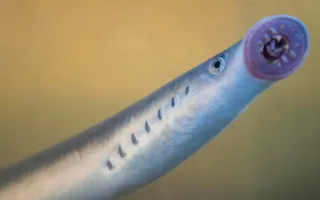Brook lamprey and our canals
The reclusive lamprey is an ancient fish that’s both rare and protected. They spend most of their life buried in silty riverbeds as larvae feeding on detritus they filter from the water. As they become adults, their digestive functions stop, and they’re unable to feed.
Given their preference for hiding in the sandy sediment at the bottom of the stream, river or canal, they’re quite hard to spot. The best time to see one is when they head upstream to spawn in shallower waters.
How to identify a brook lamprey
Brook lamprey are eel-like in shape with long and cylindrical bodies that range from 10-15cm. They are dark brown or grey with a white belly and bright yellow eyes. They have a rear dorsal fin and seven breathing holes on each side of the body, just below the eye.
This unusual-looking fish lacks gill covers and paired fins. Instead of a jawed mouth, they have a sucker disc with two tooth plates containing a few blunt teeth. As larvae, they begin life with no eyes or mouths.
Lifecycle of brook lamprey
Unlike sea or river lamprey, brook lamprey are non-migratory fish who spend their lives in the upper reaches of a river.
Spawning takes place in February and March when water temperatures reach about 9C. They lay their eggs in sand or gravel, which hatch after a few days. Young lamprey stays in the larvae stage for a few years and turns into adults when they’re about to breed and stop feeding. The adults then die after spawning.
Where to find brook lamprey
Brook lamprey are freshwater fish that hold on to the bottom of a waterway. Suckered on with the use of their mouth, they feed on bacteria, algae and other types of detritus from the water and the mud.
They are present in the Swansea Canal in high numbers and occasionally appear elsewhere on our network.
Threats to brook lamprey
The biggest threats to brook lamprey are habitat loss and pollution. They’re a rare and protected species in the UK, covered by a number of designations:
- Listed on the International Union for Conservation of Nature (IUCN) Red List of Threatened Species
- Listed on Annex III of the Bern Convention and Annex II of the European Commission Habitats Directive (3)
- Special Area of Conservation (SAC) Annex II species at a number of sites
- Protected under the Salmon & Freshwater Fisheries Act, 1975 (as amended)
Brook lamprey are not fished in our canals.





